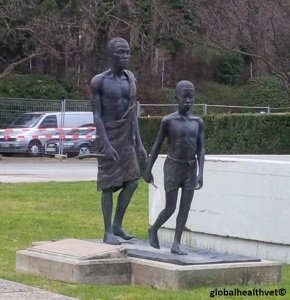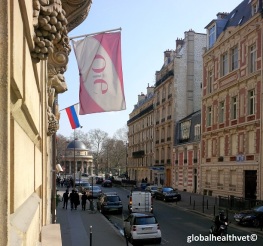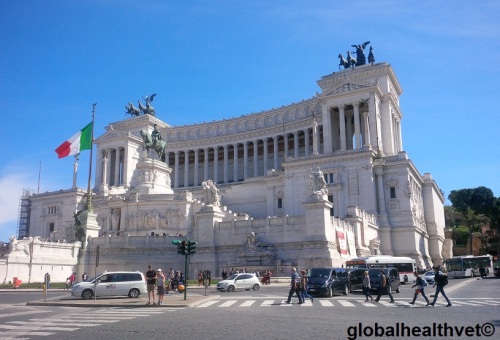(Woah…what happened here? I was supposed to post this a month ago…time flies when you’re having fun…anyways, here it is!)
After attending the One Health Congress, I had the opportunity to stay in Europe to participate in a program called Engaging Intergovernmental Organizations (EIO). This is a course organized by the University of Minnesota where participants visit international organizations promoting global health. These organizations have all recognized the need for inter-professional collaboration for years (even before the term “One Health” was coined).
World Organisation for Animal Health (OIE)
The first place visited was the OIE, based in Paris. This is the organization that represents animal health globally and is also one of the smallest of all the group visited, with about 100 employees at their headquarters. Nevertheless, they are able to promote animal health and veterinary services worldwide through a variety of projects.
The main work of OIE is to establish international standards on many aspects of animal health such as trade, animal diseases and diagnostics, animal welfare and more. These standards are referenced by a variety of national and international entities when policies are developed.
Through their World Animal Health Information System (WAHIS), the OIE monitors the global distribution of animal diseases, and keeps track of any outbreaks – which includes identifying false rumors of diseases (about 1 false rumor per month). One part of tracking disease worldwide is finding a consistent way to diagnose infections regardless of where in the world they pop up. This is done through establishing a network of national laboratories in many parts of the world that will use the same standards and protocols for animal disease diagnostics.
Another objective of the OIE is the improvement of veterinary services worldwide. To this end, the organization has set up the OIE PVS Pathways, which have several components that help countries develop their veterinary services in a sustainable way. OIE also improves veterinarians’ skills at the education level, through their Day 1 Competencies – which define the skills that every veterinarian should have at graduation from veterinary school. Finally, the organization organizes twinning programs between different veterinary universities, where students can experience the challenges and benefits of learning veterinary medicine in a different part of the world.
For the smallest of all organizations visited, the OIE does a remarkable job with a lot of diverse components and I can’t possibly list them all in one post. I invite you to check out their website to learn about their work in more detail.
World Health Organization (WHO)
The WHO is perhaps the most well-known of the organizations. Their aim is to improve health for all people globally. Specific focus areas that are part of WHO’s work include: non-communicable and communicable diseases, and emergency preparedness, surveillance and response. As the EIO group was primarily composed of veterinarians and others working in the field of foodborne diseases, our main interests were the area of zoonoses and food safety.
Speakers from WHO introduced me to the International Food Safety Authorities Network (INFOSAN). It provides public health professionals throughout the world with a forum where information about foodborne outbreaks can be shared in a fast and efficient manner. As populations rely more and more on a global food system, INFOSAN helps authorities respond rapidly to any international food-borne disease outbreak (about 40-50 outbreaks are recorded by INFOSAN each year).
Other speakers presented about the work done with neglected tropical diseases. There are 17 neglected tropical diseases (NTDs) that WHO identified worldwide, and the majority of them are zoonotic. These are infectious agents that we know a lot about about, including how they are transmitted or what symptoms they cause. In addition, most of these have efficacious treatment or prevention techniques. In other words, these diseases should not be causing much of a problem in the world. They remain however a big cause of mortality and/or morbidity, especially in developing countries. WHO recognizes that these 17 diseases still constitute a threat in 149 countries, affecting 1.4 billion people globally (for example – about 30% of all seizures in Africa are caused by zoonotic tapeworm Taenia solium). As one speaker mentioned, it’s actually not the disease itself that is neglected, but the communities they affect (there is a strong correlation between NTDs and poverty). WHO established a roadmap that outlines their work to s towards the eradication of NTDs in affected populations.

Statue commemorating river blindness (onchocerciasis) in front of WHO. The statue depicts a child leading a blind man affected by the disease.
World Trade Organization (WTO)
At first, I wasn’t super-excited about visiting WTO (economics and trade are not my favorite subjects…), maybe because I didn’t seem too veterinary or public health-oriented, and I didn’t know much about the organization to start with. Well…the visit to the WTO turned out to be one of the highlight of the trip. Basically, the WTO is a forum in which member countries can discuss and (hopefully) settle trade disputes between each other. There are a number of trade agreements that members of WTO sign and follow. During our visit, we focused on trade under the sanitary and phytosanitary measures (SPS). A full text of the SPS measure is available here. The SPS is an agreement signed by all member countries which describes how any trade of animals, animal products, plants and other foods should be conducted. This protects countries from importing goods that may endanger the local economy, environment, or public health. For example, a country that is free of foot and mouth disease (FMD) will have trade restrictions that let them trade beef from FMD-free countries only. The role of the WTO is to help find the balance between protecting consumers of a country while promoting fair trade. To settle disputes related to human, plant and animal health, countries rely primarily on the standards set by OIE, WHO or FAO that outline proper disease control efforts (in the case of FMD for example) or food safety practices (such as the Codex Alimentarius – see below). This is One Health in action and by the end of my trip to the WTO, I was able to better understand how all these organizations’ work is inter-connected.
Food and Agriculture Organization (FAO)
The final stop of the EIO group was FAO, in Rome. The main goal of the organization is to improve food safety and security for all. To carry out this mission, FAO has a lot of different departments that deal with a specific aspect of food security. Obivously, the department we were most interested in was the Animal Production and Health Division.
The biggest part of this division is the Emergency Prevention System for Transboundary Animal and Plant Pests and Diseases (EMPRES). Livestock is a livelihood for people in many parts of the world and EMPRES is the FAO’s way to monitor, control or eradicate of those infections that can severely affect farm animals. Some of the most important diseases tracked are Peste des Petits Ruminants (PPR), African Swine Fever (ASF) and rinderpest. In 2011, the FAO declared that rinderpest had been eradicated (only the 2nd infectious disease to be eradicated – after smallpox), however vigilance must remain to ensure that the disease does not come back or that samples of the virus held in laboratory are safe.
Other accomplishments of the FAO include the publication of the Codex Alimentarius, in cooperation with WHO. This is a document that highlights international standards for food safety. As mentioned above, it is frequently used as a reference during trade disputes over food safety at WTO.
During our visit, we touched on many other subjects of interests at FAO, from the challenges of antimicrobial-resistant pathogens, the Globally Important Agricultural Heritage Systems (GIAHS) – aiming to promote agriculture while preserving biodiversity – and even the use of insects as an alternative source of nutrition.
To conclude, the EIO workshop was a great way to get first-hand knowledge on how all these organizations work together to be one leg of the One Health tripod (symbolized by the Tripartite Concept uniting WHO, FAO and OIE towards a common goal). It was also really interesting to meet the content experts at each site and learn about their role within the larger organization, as well as the advantages and challenges working for each institution. I would definitely recommend this trip for anyone interested global health and international health policies, or for those looking for partnerships with these organizations.
PS
A special thanks to the organizers of EIO in Minnesota and Switzerland for their effort, my fellow attendees for the friendships, and the presenters at each organization for their time. It was a great experience!





Leave a comment